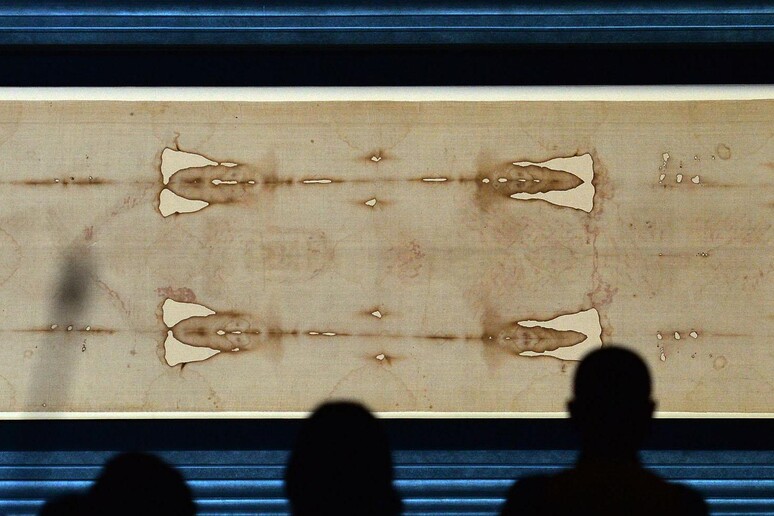Traces of possible Byzantine coins have been found on the Holy Shroud of Turin pushing back a 1988 carbon dating of the relic to the fourteenth century, according to Padua university and US researchers in a new study published in the Journal of Cultural Heritage.
The date-changing discovery was presented at the Conference on the Holy Shroud in Canada.
The study led by Giulio Fanti and Claudio Furlan detected electron, a rare and ancient alloy of gold and silver with traces of copper.
At the same time, the study examined the percentage of these elements in Byzantine coins of the eleventh and twelfth centuries and found a "full correlation", the researchers said.
Therefore, contamination of the linen with the elements in the coins was hypothesised by Fanti.
The hypothesis is that Byzantine pilgrims rubbed the cloth, believed to be the winding sheet of Jesus, in order to produce "second-degree relics by contact, for purposes of personal veneration".
The Holy Shroud is a linen cloth 4-4 metres long and 1.1 metres wide bearing the double image of a man who died following a series of tortures culminating in crucifixion.
The first historically certain news of it go back to the 15th century when French knight Geoffroy de Charny built a church in the small town of Lirey near Troyes to hold it.
Before then it left fainter marks in history.
There are texts dating back to the fifth-sixth century saying that at Edessa (today's Urfa, in Turkey) a portrait of Jesus was kept, indicated with the Greek word Mandylion, impressed on a cloth.
In the tenth century the Mandylion was said to have been moved to Constantinople, at the time capital of the Byzantine Empire.
With the Sack of Constantinople and the theft of countless precious objects, it was assumed that the Shroud was taken by the Latins to Greece, where the Charny family was present.
In the first half of the 15th century Marguerite de Charny took the Shroud from the church in Lirey.
In 1453 it was transferred to the Savoy royal house which remained owners until 1983, when it was bequeathed to the Holy See.
Believers revere the Shroud as the cloth in which Christ's body was wound after he was laid down from the Cross.
But there have been several studies that have found it is probably a medieval fake.
Last year a new study said at least half the bloodstains on the Shroud are fake.
Only some of the stains are compatible with the position of a crucified man, while others do not find justification in any position of the body, either on the cross or in the tomb, said the study carried out by Matteo Borrini of the University of Liverpool and Luigi Garlaschelli of pseudoscience exposé group CICAP.
The experiment, which used forensic-science methods to reconstruct the formation of the stains, was published in the latest issue of the Journal of Forensic Sciences.
"We did not analyze the substance that formed the stains but we wanted to verify how they could have been formed on the shroud," Borrini told ANSA.
To do this, crucifixion was simulated on one of the authors of the study, Garlaschelli, using both real and artificial blood.
"We simulated crucifixion on crosses of different shapes, different types of wood and using different positions of the body, such as with horizontal arms that were parallel to the ground and ones in which they were vertical, above the head," Borrini said.
Thanks to this experiment in the line of how crime scenes are reconstructed, the researchers reconstructed the way in which the blood stains were formed on the wrists, forearms, those due to chest wounds and blood stains around the waist on the shroud.
This showed that the stain on the trunk is compatible with the position of a crucified man, as well as the "stains on the forearms, which indicate that the arms were stretched very high, in a position over 45 degrees".
However, the stains on the wrist and in the lumbar area "cannot be justified in any position of the body, either on the cross or after buried", he noted.
The experiment showed that one of the stains is entirely unrealistic, one that is shaped like a belt around the lumbar area, due to the possible bleeding after the death from a wound to the side, whether when the body was laid in its burial position or when it was wrapped in the shroud.
"Our experiments on a mannequin," the researcher said, "showed that in this case the blood would not have arrived at the kidney area, and would have instead accumulated in the area of the shoulder blade." The researchers believe that this stain, similar to a belt, "seems a mark made in an artificial manner, using a market or a finger".
All of these results, taken together lead to the conclusion that the shroud is an artistic product "in line with previous analyses, such as carbon dating, which have shown that the shroud was made in the Middle Ages".
Nevertheless, because of the mysticism surrounding the Shroud, it has captured the imagination of Church officials, Catholics, theologians, and historians - and even the occult-obsessed Nazi dictator Adolf Hitler.
Monks revealed in 2010 that during the Second World War, the Shroud was hidden in an Benedictine sanctuary in the southern Campania province because it was believed that Hitler wanted to steal the Shroud to use in a black magic ceremony.
The debate over whether image is truly that of Christ, or a very good forgery, have lasted centuries.
Radiocarbon-dating tests conducted on the cloth in 1988 suggested it dated from between 1260 and 1390; however, other scientists have since claimed those results could have been distorted by centuries of contamination.
That has led to calls for more testing, which the Vatican has consistently refused.
ALL RIGHTS RESERVED © Copyright ANSA











